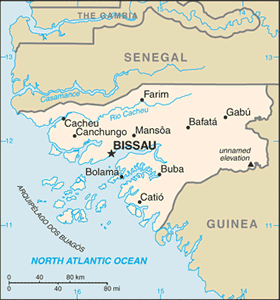The Geography of Guinea-Bissau
The Geography of Guinea-Bissau
Guinean Geography
Location: Western Africa, bordering the North Atlantic Ocean, between Guinea and Senegal
Geographic coordinates: 12 00 N, 15 00 W
Map references: Africa
Area: total: 36,120 sq km land: 28,000 sq km water: 8,120 sq km
Area - comparative: slightly less than three times the size of Connecticut
Land boundaries: total: 724 km border countries: Guinea 386 km, Senegal 338 km
Coastline: 350 km
Maritime claims: territorial sea: 12 nm exclusive economic zone: 200 nm
Climate: tropical; generally hot and humid; monsoonal-type rainy season (June to November) with southwesterly winds; dry season (December to May) with northeasterly harmattan winds
Terrain: mostly low coastal plain rising to savanna in east
Elevation extremes: lowest point: Atlantic Ocean 0 m highest point: unnamed location in the northeast corner of the country 300 m
Natural resources: fish, timber, phosphates, bauxite, clay, granite, limestone, unexploited deposits of petroleum
Land use: arable land: 8.31% permanent crops: 6.92% other: 84.77% (2005)
Irrigated land: 250 sq km (2003)
Natural hazards: hot, dry, dusty harmattan haze may reduce visibility during dry season; brush fires
Environment - current issues: deforestation; soil erosion; overgrazing; overfishing
Environment - international agreements: party to: Biodiversity, Climate Change, Climate Change-Kyoto Protocol, Desertification, Endangered Species, Hazardous Wastes, Law of the Sea, Ozone Layer Protection, Wetlands signed, but not ratified: none of the selected agreements
Geography - note: this small country is swampy along its western coast and low-lying inland


